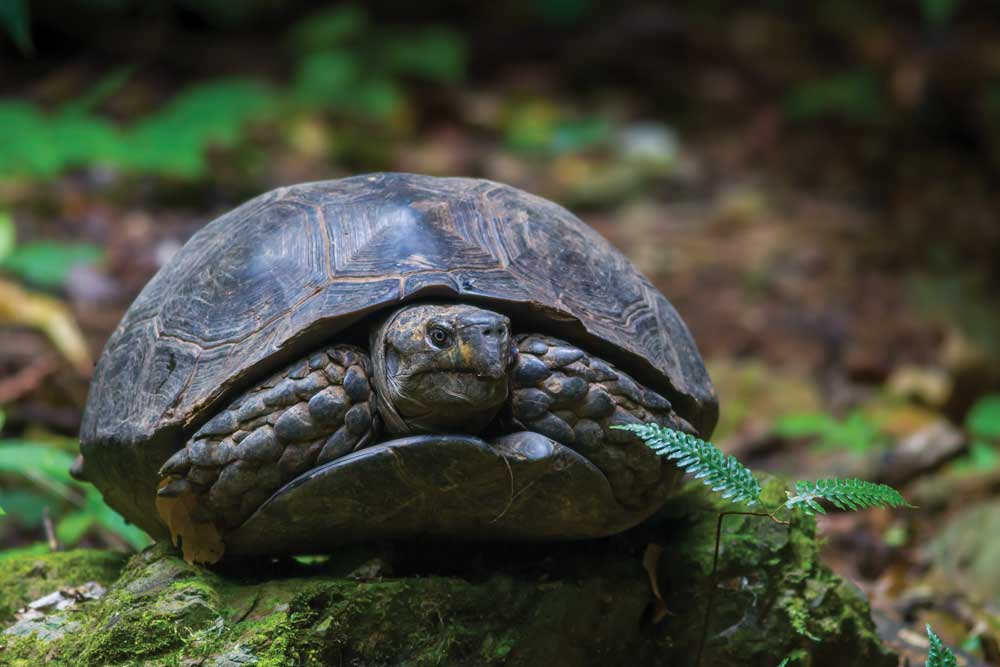Asian giant tortoises (Manouria emys phayrei), also known as the Asian forest tortoise, were once abundant throughout Northeast India but are now rarely found in the wild there.
Sushmita Kar recalls collecting eggs from the nests of Asian giant tortoises (AGT) as early as March during her years as a researcher and conservationist at Nagaland Zoological Park in Nagaland of Northeast India. However, Kar notes that over the past five years, the tortoises’ nesting season has been gradually delayed, which she attributes to late monsoons.
“Right before the monsoon, they start collecting leaf litter to build their nests, sweeping the forest floor, and completely dissociating from the males,” said Dr. Shailendra Singh, Director of TSA Foundation, India (TSAFI). This year, more than a month past the usual egg-laying season, the tortoises still showed no signs of laying eggs. Although they had punctually built their nests during the nesting season, they abandoned them completely. Instead of returning to their newly built nests to lay eggs as expected, the tortoises showed no inclination to do so and were instead busy feeding elsewhere in their enclosure.
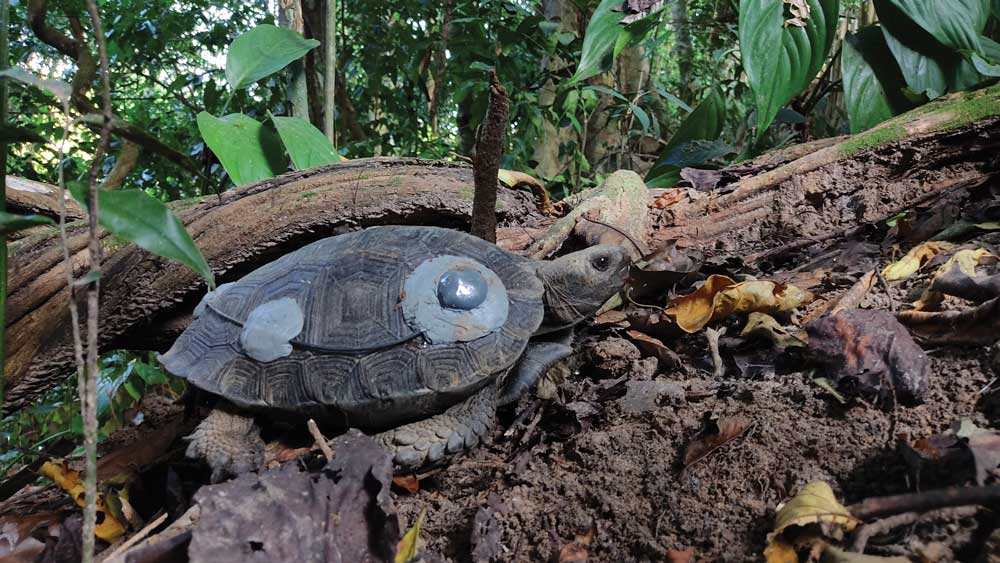
A radio tagged AGT from our pilot release in Intanki National Park.
Asian giant tortoises (Manouria emys phayrei), also known as the Asian forest tortoise, were once abundant throughout Northeast India but are now rarely found in the wild there. “We estimate that there are fewer than 500 adults surviving in the entire northeast region of India,” said Dr. Singh. Unfortunately, traditional and commercial hunting and forest destruction are threatening the existence of this species, which has been assessed as critically endangered by the IUCN Red List. AGTs are one of two known species representing the genus Manouria (Testudinidae), the other being the Impressed tortoise (Manouria impressa).
Singh and his colleagues report in a 2024 paper that the population of the Manouria genus has declined by over 80 percent in the last three generations, driven by factors such as deforestation, subsistence collection, and poaching for the international pet trade. Therefore, Kar, along with Dr. Shailendra Singh and their team, have been involved in the captive breeding of Asia’s largest tortoise species in an enclosure located inside the Nagaland Zoological Park.
In 2017, TSA Foundation India partnered with the Nagaland Forest Department to establish the country’s largest conservation-breeding facility for Asian giant tortoises inside the Nagaland Zoo in the Dimapur district of Nagaland. During community surveys throughout Nagaland, Singh and his team discovered that local communities were sporadically keeping these tortoises as pets across the region. “Initially, they planned to eat them but eventually decided to keep them as pets.”
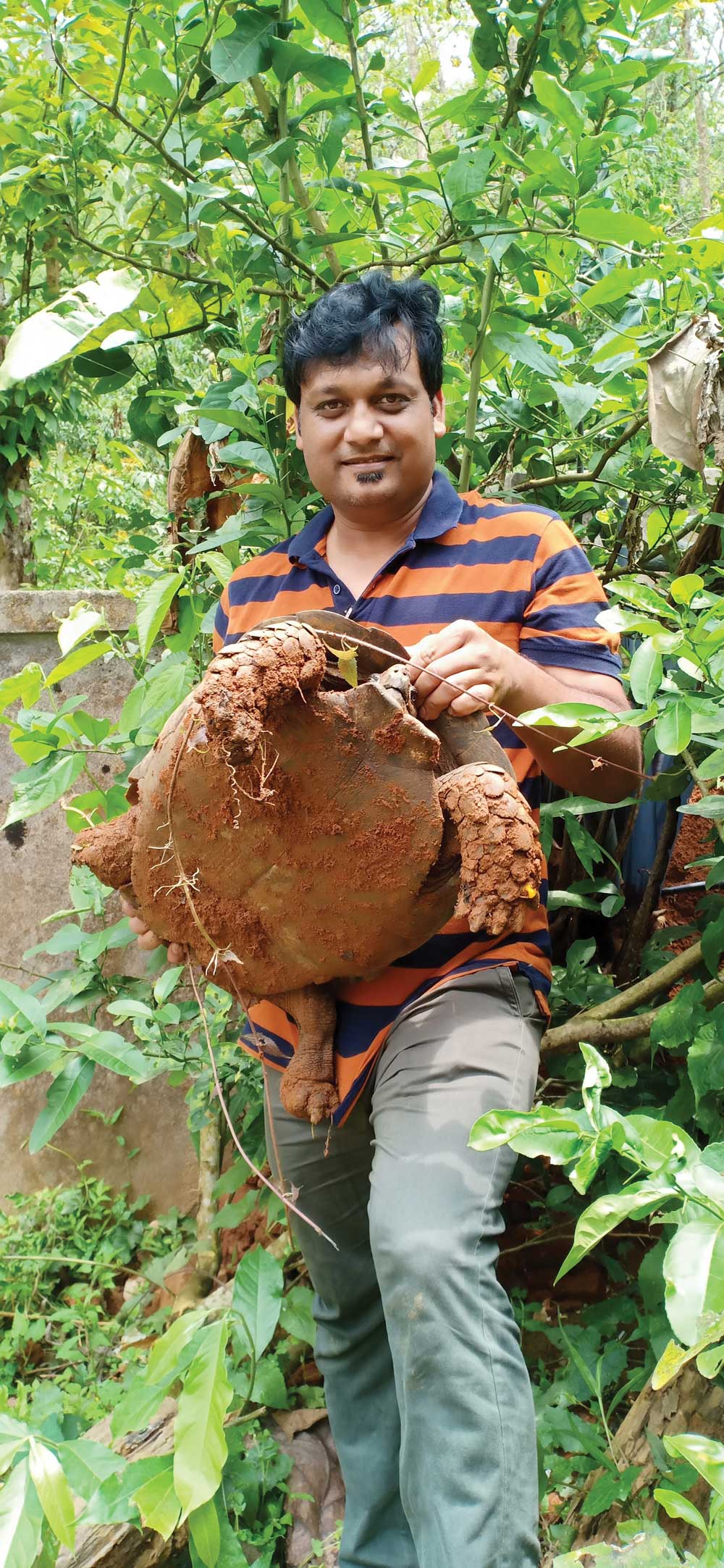
Dr. Shailendra Singh holding an adult Asian giant tortoise at Nagaland Zoo during initiation of conservation breeding programme. Photo by Jayaditya Purkayastha
Singh says his team worked hard to convince the locals that they were on an educational and conservation mission. Gradually, the locals donated their pet AGTs to the zoo, providing the research team with their first breeding individuals to start their conservation breeding program. The team began their work in 2017, motivated by the goal of eventually reintroducing captive-bred AGTs into the wild to rebuild a viable population of the species in Northeast India.
“Right now, we have about 100 individuals that we bred over the last 7 to 8 years inside our enclosure spanning 0.2 hectares,” Singh said. “Last year, we released 10 animals with radio transmitters in Ntangki National Park, and this year, we are again releasing 10 animals in a community-managed forest,” said Dr. Singh.
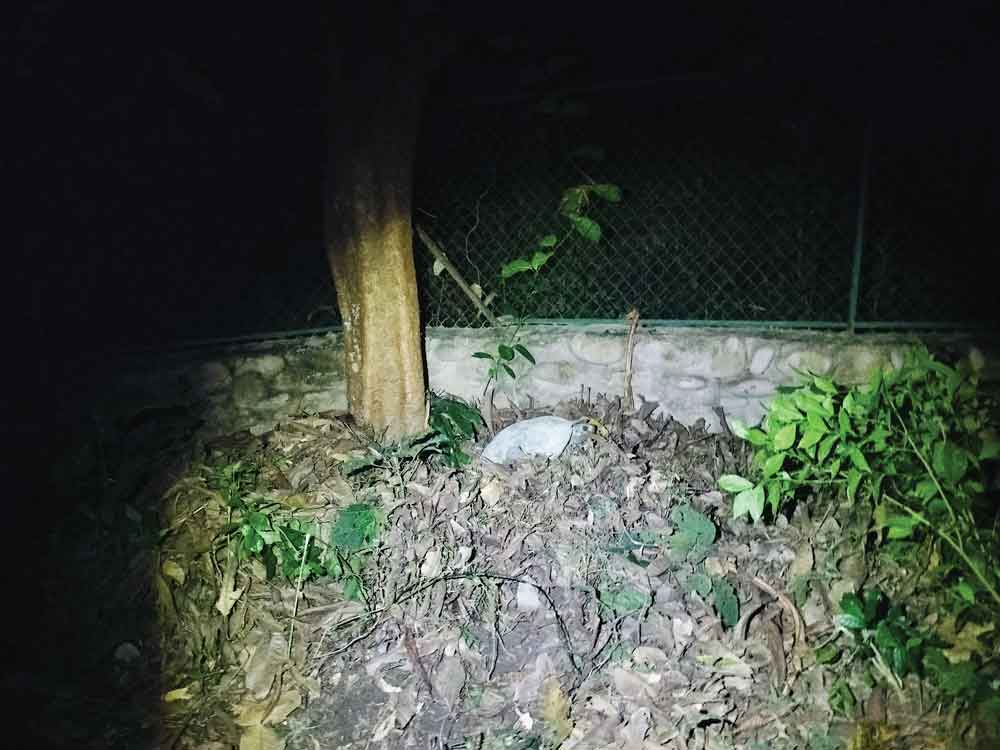
This female came back to nest after the experiment began. Photo by Sushmita Kar
“This year, there was rainfall, but it came very early, and then there was a dry spell with no rain at all,” said Kar, a Ph.D scholar at the Department of Forestry, NERIST, Arunachal Pradesh, and also a regional coordinator for TSA Foundation, India. “They wait for the rain,” said Dr. Singh. As the rain arrives, the fine material of the forest floor starts to decompose, raising the temperature of the litter slightly, which Singh says “is required for the incubation of the eggs” and also helps maintain the right amount of moisture.
“So if something goes wrong with temperature or the monsoonal shift, it’s the reason why all four of our tortoises abandoned their nests this year,” said Dr. Singh. “They made the nests, they were waiting for the monsoon, but the monsoon did not arrive. Their incubation is totally dependent on the incubation temperature as well as the nest incubation humidity,” said Dr. Singh. He added that lower incubation temperatures cause most of the offspring to become male, and the exact opposite happens with higher temperatures. “So they have to balance out one or two degrees of temperature,” he said.
Starting at the end of April, Kar and her team tried to get the tortoises to return to their nests by manually sprinkling water over the enclosure using water sprinkling devices, but to no avail. They were attempting to trick the animals into thinking that the monsoon had arrived, but even by the middle of May, they had received no response from the tortoises. The researchers began to worry that they would not have any tortoise offspring to breed. After much consideration, the team decided to add another element to their experiment: “thunder sounds!”
The team set up a remotely controlled, solar-powered audio system with speakers and began playing rain and thunder sounds inside the tortoise enclosure every evening after dusk for about 15-20 minutes, twice an hour apart, while continuing to sprinkle water as usual. They executed this new combination for seven to 10 days. Dr. Singh explained that their artificial setup closely resembled the soundscape of natural thunder, with speakers placed on treetops and controlled remotely by a solar-powered monitoring system.
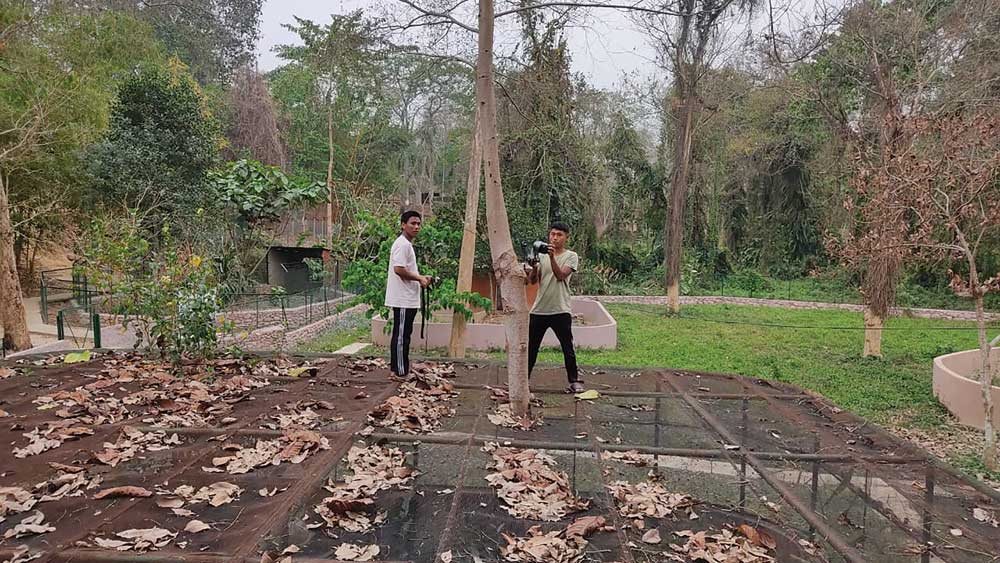
CCTV audio visual device positioned at the top of AGT enclosure to simulate thunder. Photo by Sushmita Kar
“During the day, the tortoises might realize that it’s not actually raining, but at dusk, it’s essentially dark, and they might be tricked into believing that it’s real rain, even though we’re manually sprinkling the water,” said Dr. Singh. To their surprise, all four of their breeding tortoises finally returned to their nests. Fortunately, one of them even laid its eggs around mid-June, providing the researchers with this year’s offspring to breed. Nonetheless, the research team was left perplexed by the success of their experiment.
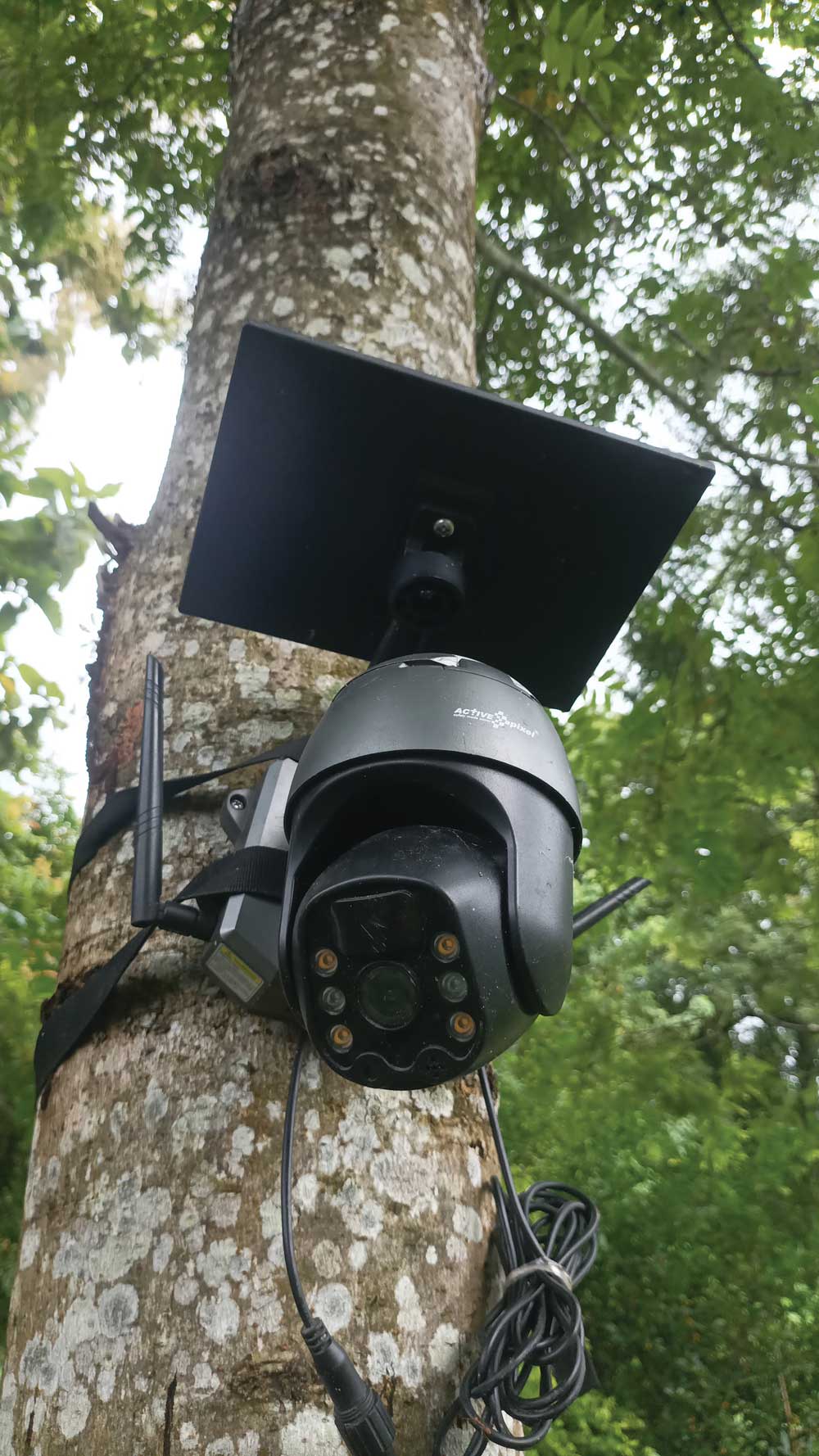
CCTV audio visual device
“It doesn’t surprise me that you could make them think there is thunder because they are definitely able to hear things,” said Dr. Craig Stanford, professor of biological sciences at the University of Southern California and Chair of the IUCN Tortoise and Freshwater Turtle Specialist Group. Dr. Stanford and his graduate students researched Asian giant tortoises in Southeast Asia in the 2000s. He emphasizes that chelonians (turtles and tortoises) have a very different sense of hearing than humans. “They hear things at lower frequencies, so they perceive sounds through ground vibrations.”
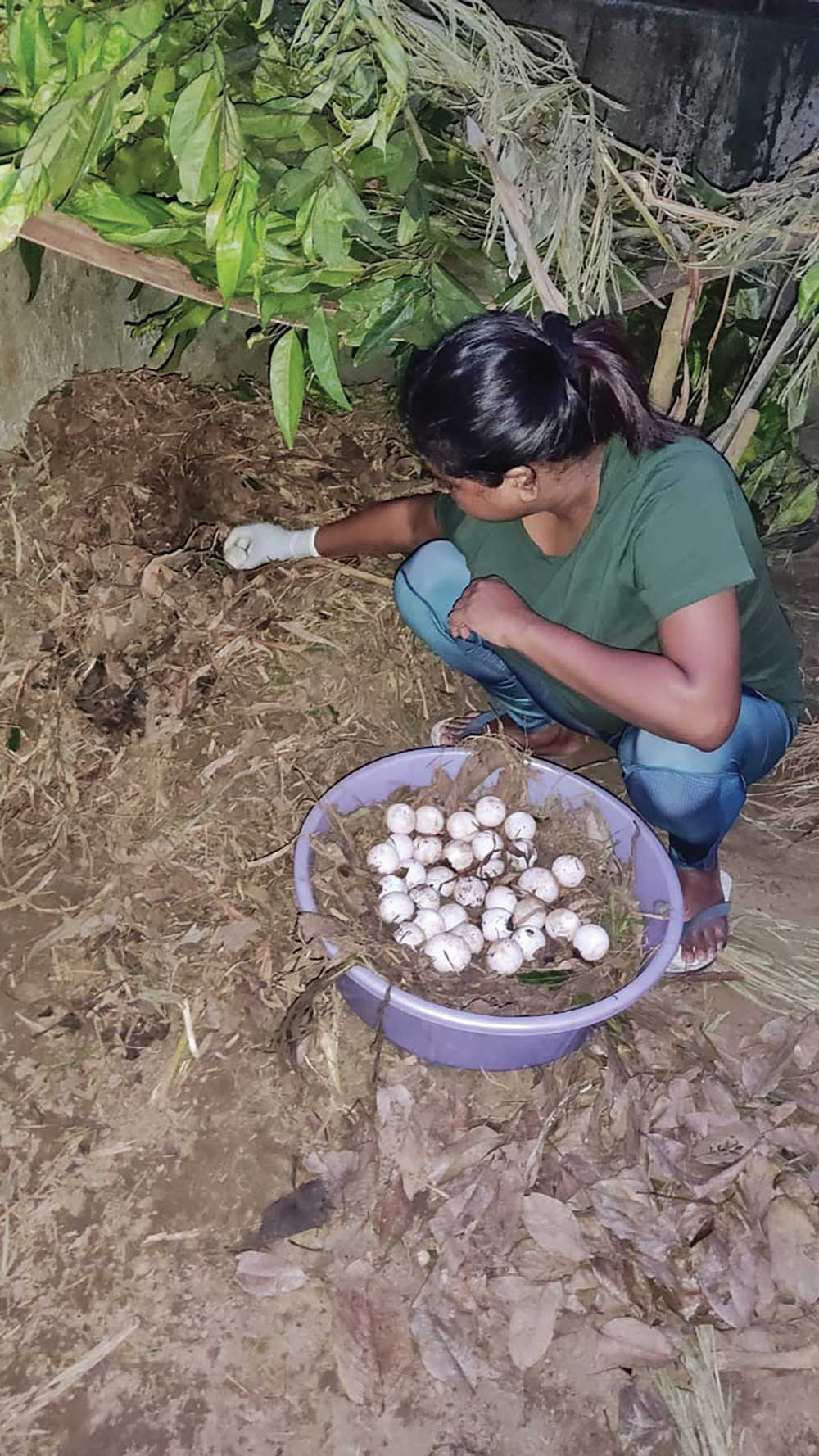
Collecting eggs for incubation. Photos by Ika Chishi
“Most animals breed during particular times of the year, and the primary cue for this is usually temperature for reptiles and amphibians,” Dale DeNardo, D.V.M., Ph.D., professor and Arizona Zoological Society Chair of Vertebrate Zoology, School of Life Sciences, Arizona State University, replied in an email.
“Species in the tropics rely on humidity or rainfall as cues,” DeNardo said. “It is likely that the tortoises begin egg production during the latter part of the dry season based on temperature or possibly day length, but then delay nesting and laying the eggs until there is ‘confirmation’ that the monsoon has started.” DeNardo further explained that laying eggs once the rains have begun increases the likelihood that the eggs will not desiccate during incubation. “Hatching can take a wide range of months because it is delayed until the substrate becomes moist, signaling the onset of the rainy season and thus more forage for the newborn tortoises,” he said.
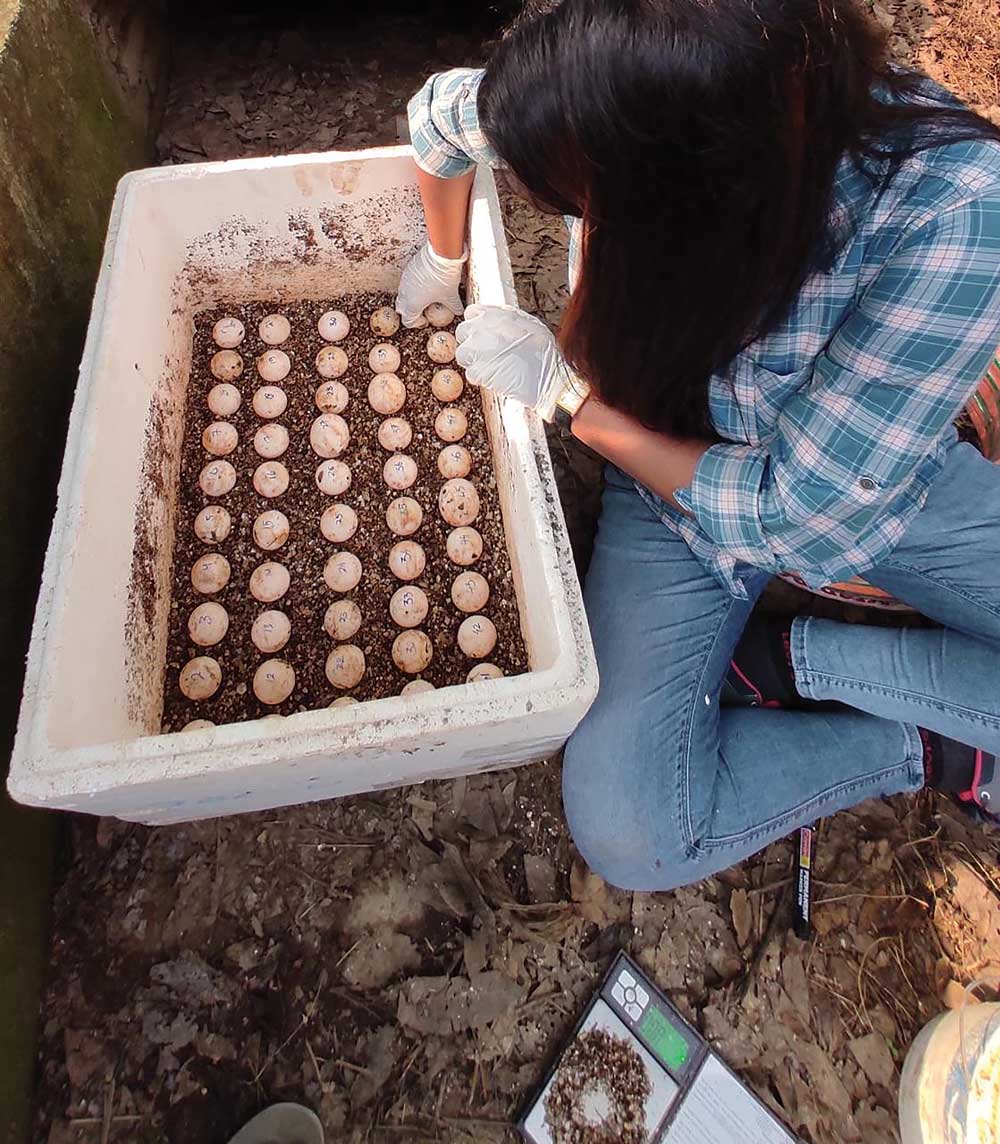
Artificial incubation of AGT eggs at Nagaland Zoo. Photo by Lalit Budhani
DeNardo suspects that the AGTs sense the moisture (and also the vibrations from artificial thunder) and thus decide that the monsoons have started. “Desert toads underground can feel the vibrations of hard rain hitting the surface even before any moisture reaches them,” he said. “The AGTs had initiated the reproductive process but were holding off on nesting until there was evidence, albeit artificial, that the rains had started.”
Kar recalled that last year, when the team was collecting eggs from the tortoises’ nests, they observed that the nests were built with a mix of wet and dry leaves. The researchers measured the temperature inside and outside the nests and found that it was 2 degrees cooler inside the tortoises’ nests.
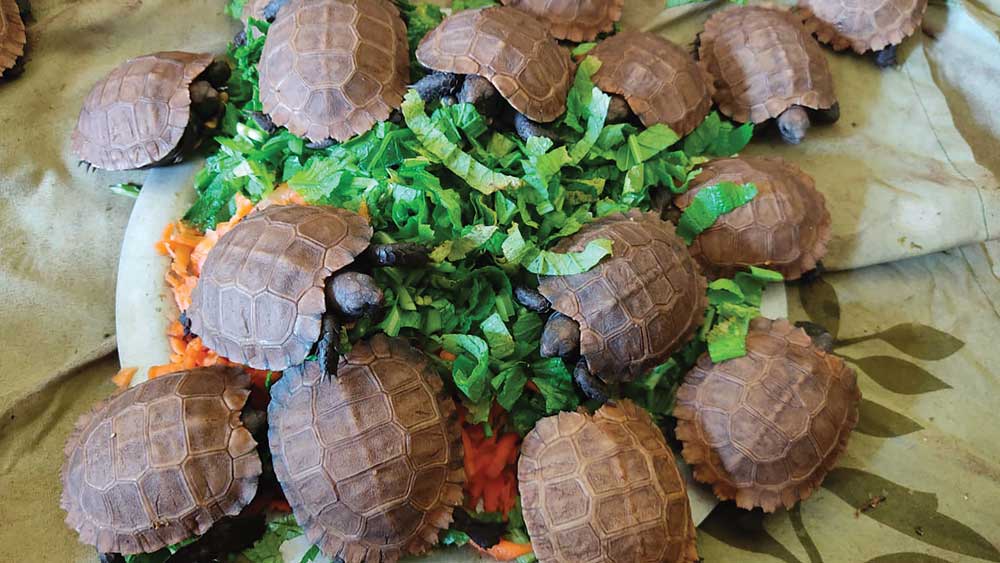
These are captive bred AGT hatchlings being fed at Nagaland Zoological Park. Photo by Sushmita Kar
“So I think they also need a mix of dry and wet leaves to build their ideal nest,” said Kar. “That’s why I think they think that if it rains, ‘they will also be able to get some wet leaves’.” The AGTs lay their eggs in their nests and cover them with a mix of the same leaf litter, which helps maintain the appropriate incubation temperature and humidity. After the tortoises lay their eggs, the researchers collect the freshly laid eggs from the nests to artificially incubate them in their laboratory, also located inside the zoo, to ensure successful hatching. Kar explains that the ambient temperature at the captive breeding site inside the zoo rises above 36 degrees Celsius during June and July, which could prove lethal to the eggs.
She adds that the zoo’s climatic conditions are very different from the tortoises’ natural habitat, making it extremely hot and thus unsuitable for hatching the eggs in natural conditions. Furthermore, despite building an enclosure, the eggs are still vulnerable to predators such as monitor lizards and mongooses.
“That is why we have to take all the eggs to artificially incubate them,” said Kar. They replace the eggs with ping-pong balls, “the ones we used to play with in our childhood,” she explained, hoping the tortoises don’t notice. However, “once they realize their eggs have been stolen, the females become very stressed,” added Kar. She recalls an incident two years ago when a female tortoise started attacking her male mates after discovering the egg theft. “She lunged at any male who came over to pacify her!”
Inside the World of the Asian Giant Tortoise
Asian giant tortoises (Manouria emys phayrei) are the largest mainland tortoise species in Asia, reaching up to 60 centimeters in shell length and weighing up to 37 kg. When researchers studying AGTs in Myanmar asked villagers to describe the animal, the villagers often said, “The tortoises are so large that children can ride them.” AGTs are considered one of the oldest tortoise lineages in the world. These tortoises inhabit the tropical and subtropical hilly wet forests of Bangladesh, India, Indonesia, Malaysia, and Myanmar. “They are dwellers of mountain forests, living within a very narrow range of humidity and temperature, and in a gradient of the environment,” said Dr. Singh.
The tortoises primarily inhabit the foothills of larger mountain ranges. “They eat lots of greens and other vegetation,” said Kar. She emphasized that AGTs are mostly herbivores and consume whatever they find on the forest floor, including leaves, fruits, tubers, and other plant matter. She added that there are records of them eating arthropods and insects, but she has not observed this behavior herself.

This female was initially building a nest. You can see back sweeping in the photo but later the nest was abandoned. Photos by Sushmita Kar
“Tortoises are adapted to live on land whereas turtles are either in water or in the water part of the time,” said Dr. Craig Stanford. “Their feet are very different: tortoises have feet that are more like clubs, while turtles have feet with webbing between their toes.” In a 2020 paper titled “Turtles and Tortoises are in Trouble,” published in Current Biology, Dr. Stanford and his colleagues highlighted the crucial role chelonians (turtles and tortoises) have played in global ecosystems for approximately 220 million years—starting around the same time dinosaurs first began to evolve on Earth.
In both land and aquatic ecosystems, turtles and tortoises play critical roles in seed dispersal, mineral cycling, and carbon storage, the researchers wrote in their 2020 paper. The paper also illuminated that chelonians have been an integral part of human culture for about 400,000 years. “We have evidence of primitive people cooking them in campfires, including ‘earlier species of humans,’ like the Neanderthals,” said Dr. Stanford. He added that the world used to have many more turtles and tortoises.
Dr. Stanford emphasized that these animals play an important role in the ecological cycles of the world. “They were scavengers who removed dead animals.” He asked if I knew about “large turtles that were introduced a few years back into the Ganges River to eat the remains of human flesh, cows, or anything else polluting the water at Varanasi.” He added that “sea turtles” might have once been the most abundant animals on Earth, “but of course, they no longer are.” When asked if chelonians still perform their scavenging role today, Stanford replied, “Yes, of course, it’s just that their populations are much, much smaller.”
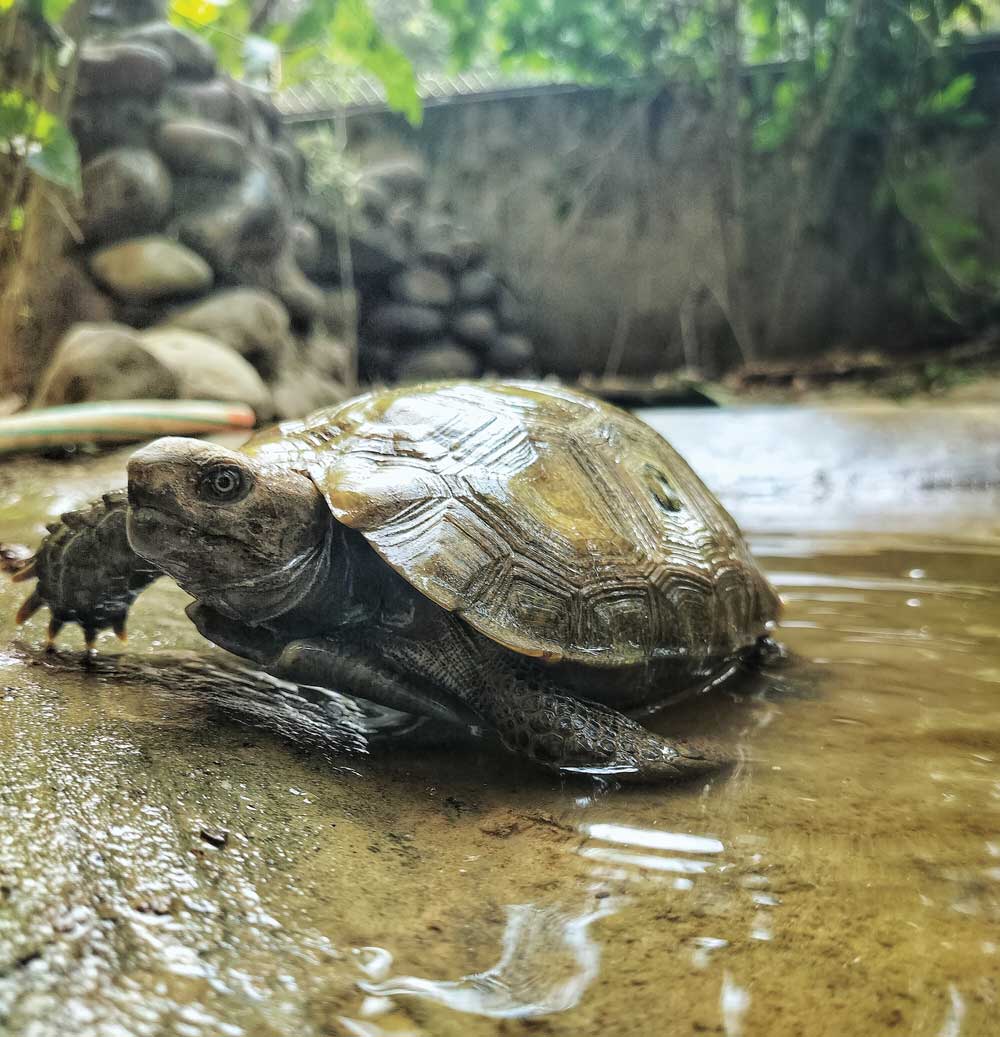
This is a juvenile from Nagaland Zoo. Photos by Sushmita Kar
A 2018 paper coauthored by Dr. Craig Stanford, Dr. Shailendra Singh, and several other researchers, published in Chelonian Conservation and Biology, analyzed all 360 recognized species of turtles and tortoises, both extant and recently extinct. The researchers found that 20 percent of the species were Critically Endangered, 35.3 percent were either Critically Endangered or Endangered, and 51.9 percent were threatened overall. They also discovered that 56.3 pecent of all data-deficient species were likely threatened. The paper highlighted that the family Testudinidae faced the highest level of threat among all Testudines, largely due to the extinction of several species of giant tortoises from Indian and Pacific Ocean islands since 1500 CE.
The Order Testudines is the taxonomic category that includes all turtles and tortoises. Additionally, the researchers noted that the Order Testudines is, on average, more imperiled than all other larger orders of Reptilia, Amphibia, Mammalia, or Aves. This indicates that turtles and tortoises are generally in worse conservation shape compared to other large groups of animals.
“If you look at the AGTs’ forelimbs, they are like elephant-like, very heavily scaled,” said Dr. Stanford. “Their legs are very sturdy, and nothing can scratch or penetrate that surface.” Stanford adds that the animals can climb up cliffs and waterfalls with ease. Kar shared stories from village elders in Nagaland, who recalled that the tortoises are adept climbers, “sometimes they roll down from hills into narrow streams, using their carapace as a shield to conserve energy.” Kar also mentioned that when speaking with Naga communities, she often refers to the Asian giant tortoises as the “small elephants of the forests” due to their crucial role in seed dispersal and forest regeneration. “Large portions of Nagaland are elephant corridors so the idea was to introduce AGT to people with something they can relate with.”
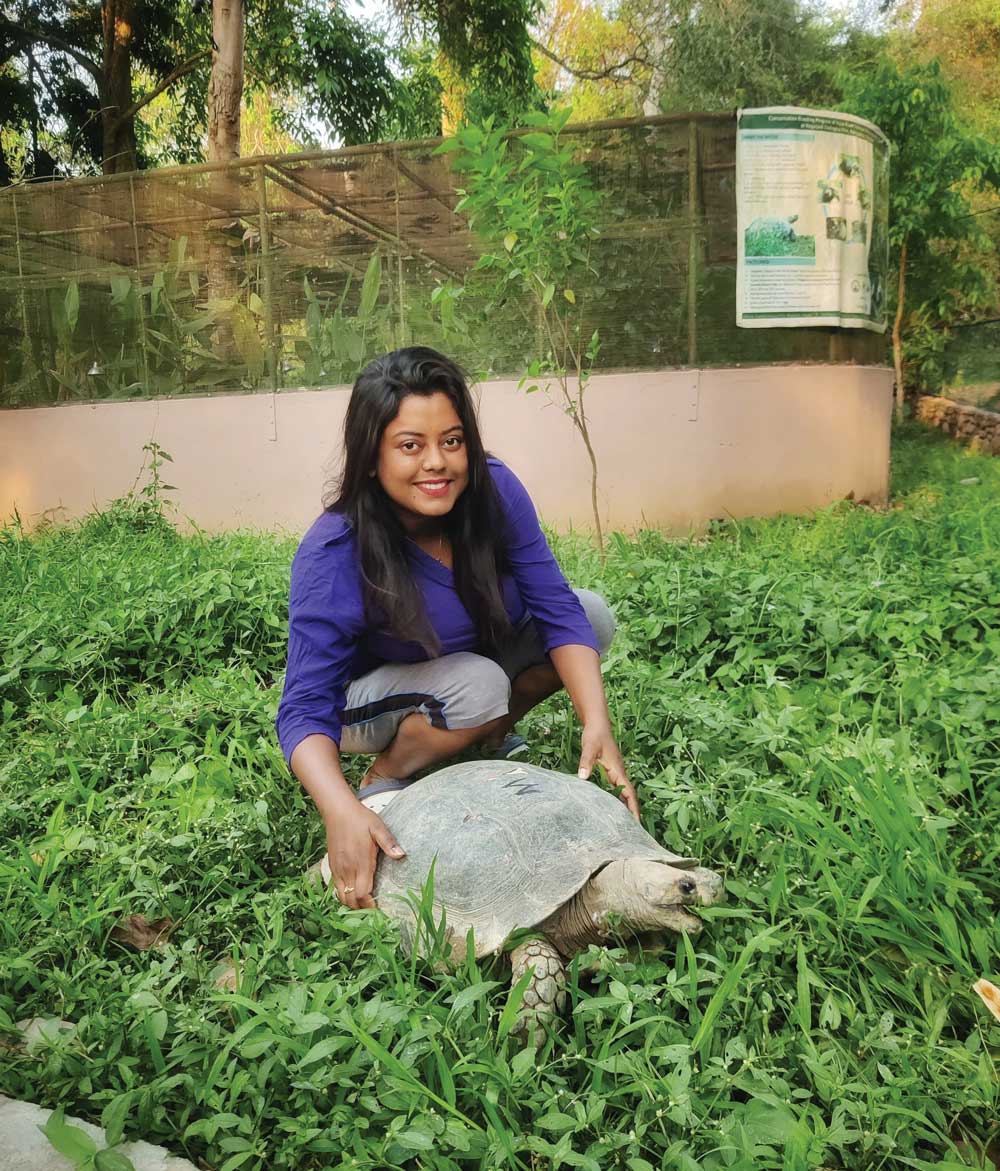
Sushmita Kar with an adult female Asian giant tortoise in Nagaland. Photo by Shailendra Singh
“During the monsoon, the bamboo shoots grow, and the AGTs come there, jumping with joy and eating the shoots voraciously,” said Kar. Kar, Singh, and Stanford all emphasize that these tortoises have personalities unlike any other. AGTs are the only chelonians that build a nest to deposit their eggs. Normally, other tortoises and turtles just dig the soil and lay their eggs. After depositing the eggs, AGTs also show parental care by sitting over the nest and guarding the eggs, a behavior not observed in other chelonians. The tortoises spend well over a week building their nests continuously; “they stay the night,” exclaimed Kar. While building their nests, they even refrain from eating and focus solely on this task.
The Intelligence of the Asian Giant Tortoise
“They are fascinating and very intelligent animals; they have excellent memories and are more intelligent than most turtles and tortoises,” Stanford said. “They are very attentive to their keepers and seem to know individuals quite well,” added Dr. Stanford. He explains that the animals follow their keepers around, a behavior that has earned them the nickname “dogs of the tortoise world” due to their responsiveness, “unlike most tortoises that don’t respond to people that much.” Back in the USA, Dr. Stanford had kept an AGT at his home, which fueled his early interest in these species. “They are bred all around the world. In the US, thousands have been bred in captivity,” he said.
Talking about their quirky experiment, Kar says that it is a success for her and that she is definitely surprised by it. “The awareness level of people here is low, so if people understand the work we do and come join us, that is a success for us.” “If in 10 or 20 years, we build a viable population of these animals, which are not brought into notice like other bigger charismatic creatures, that will be one of the biggest successes of my life,” said Kar.
Dr. Singh says that his team will be more prepared and equipped next year if the monsoon becomes tumultuous again. “We will have to experiment with automatic sprinklers, more thunder and rain sounds,” said Singh. Dr. Singh is also planning to train the animals for release into the forests. “We need to train them on how to find the right kind of feed and the right environment to live in,” he added.
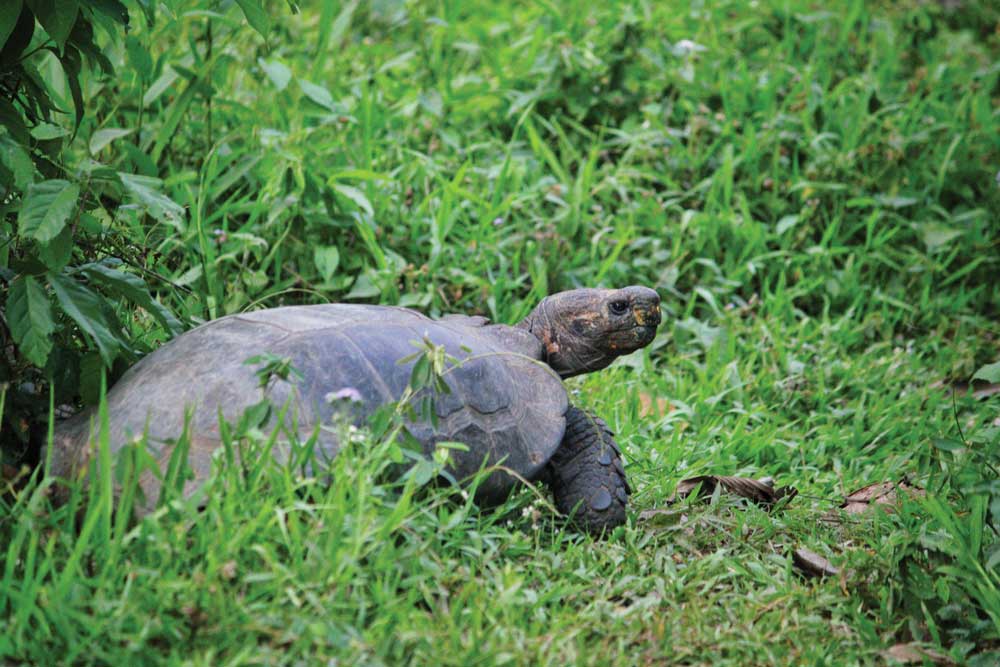
An adult from Nagaland Zoo. Photos by Sushmita Kar
“Habitat loss is always the biggest problem facing turtles and tortoises, as well as every other animal and plant species on Earth,” said Dr. Stanford. He further emphasized the need to change the culture, particularly in Asia and East Asia, in places like China, to stop people from consuming tortoises “in the numbers they do.” He added that we also need to focus on protecting species that are currently being widely smuggled in the pet trade.
A research paper from 2015, published in Biodiversity and Conservation, analyzed the trade of tortoises and freshwater turtles in one of Southeast Asia’s largest wildlife trading centers, the Chatuchak Market in Bangkok, Thailand. The study found that 97 percent of the individuals for sale were from Thailand, Africa, South Asia, and Southeast Asia. The researchers stressed the need for legal reforms in Thailand to bring an “end to the illegal trade in tortoises and freshwater turtles in Thailand.”
Asian Giant Tortoise Information
“Since the AGTs are large, they are hunted by the local tribes,” said Dr. Singh. “Because they are big and have more meat than smaller turtles, there is a high chance that the Indigenous people will kill them whenever they come across one while venturing through the forests,” said Kar. “The people get their nutrition, their protein!” Kar further reminisces about venturing deep into the forest, saying she has been to the Indigenous people’s homes and has lived with them.
“If you wake up one morning and there is jungle everywhere around you, with nothing else, even to reach a decent little shop, you have to travel 4-5 kilometers on foot and then some 20 kilometers by vehicle. Therefore, all they have is the forest and its resources; they don’t have any other options.”
The chelonian’s shell, which is incredibly hard and boulder-like, is an ancient adaptation that predates the origins of mammals and birds. Over their long evolutionary history, many turtle and tortoise species have developed life cycles characterized by late maturity, prolonged reproductive periods, and remarkable longevity.
However, these traits, which once ensured their survival, have now made them vulnerable to extinction in the face of our rapidly changing world, writes Dr. Stanford and his colleagues in their 2020 paper. Stanford says that if you reach adulthood as a tortoise, you will probably live many years. “So you can reproduce slowly, be protected against danger because of your shell, and live a very long time, being reproductively successful over a century, but unfortunately, your shell won’t protect you from people.”
Manish Koirala is a freelance science journalist from Nepal with a Bachelor’s degree in Environmental Science from Kathmandu University. He focuses on environmental topics and enjoys sharing stories that highlight important issues.
References:
https://meridian.allenpress.com/ccb/article-abstract/17/2/135/10774/Global-Conservation-Status-of-Turtles-and
https://www.cell.com/current-biology/fulltext/S0960-9822(20)30636-9
https://journals.ku.edu/reptilesandamphibians/article/view/21341
https://link.springer.com/article/10.1007/s10531-014-0809-0
https://www.semanticscholar.org/paper/Distribution-records-and-conservation-status-of-the-Platt-Platt/b88b2efecaa6015616b0986ecfc456bc97cb1a75

